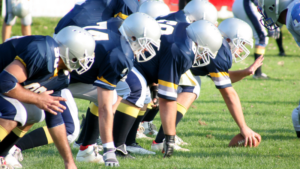The discus throw is a very technical track and field event, so athletes cannot expect to just jump in and excel. In fact, discus is an activity that may even take years to master and properly perform. Perfecting the complicated technique takes loads of work, but by implementing good habits, technique, and exercises, throwing can be greatly improved. Basically, if you’re looking to get into the discus, there is officially no better time to start than now. Take CoachUp’s handy tips, tricks, and fun exercises with you in order to fully understand the discus, good luck!
Although the concept is simple, the technique is not easy to excel at. For track and field athletes to compete at the highest levels, they need to know how to throw the discus correctly and efficiently. Now, in order to do so, you must fully comprehend the basics of the grip, rotation, and release.

GRIP
The technique for throwing discus is, believe it or not, very different from any other athletic throw. It might not surprise you, but throwing the discus is nothing like tossing a baseball. To grip the discus, throwers need to spread their fingers out and use the first knuckle of each finger to secure the discus. The index finger should be in line with the thrower’s wrist, while the thumb is excluded from the grip and is used for balance.
It may seem like a long list of things to worry about initially, but don’t worry, over time these things will get easier. But, for now, don’t worry about the distances on your throws, but instead on becoming comfortable with the technique. It may take a while to make sense the outstretched fingers depending on your hand size, so, again, focus on the basics. If you set your sights on stardom immediately, you’ll struggle. Build great foundations at first and then the sky is your limit.
ROTATION
In a sense, the rotation is the most important part of the discus throw, so don’t attempt to cut corners on this either. Unfortunately, it also happens to be one of the most difficult aspects of the throw as well. Stay strong and focused and we promise that you’ll improve in no time.
Begin facing away from your target in an athletic starting stance. Stand with legs staggered, spread slightly wider than shoulder-width apart, and knees bent. The lead up to the rotation involves one or two swings of the arms back and forth without foot movement. This motion helps establish a rhythm for your footwork. Bring your throwing arm back behind your right shoulder as far as possible, with the non-throwing arm outstretched in the opposite direction, this will help you balance during the spin. Weight should be placed on the right foot with the left foot ready to pivot.
Next, start to pivot on the balls of your left foot, while simultaneously swinging your shoulders to the left. The right foot is then lifted off the ground and the spinning begins. As you face the target direction, you should jump-turn off of your left foot to land on your right foot in the middle of the circle. The rotation will continue while this foot is planted. The left foot will then follow the right as the turn is completed and should end up planted directly in front of the right foot. The left foot should be pointed towards the direction of the throw.
Although the athlete will complete 1.5 turns during this motion, they must always be moving in the direction of the target. The rotation sounds complicated because it is! This will, no joke, probably take the most effort and practice of the entire process as it involves balance, concentration, and proper footwork. Properly rotating your body to maximize power takes a lot of practice.
RELEASE
Once the rotation is complete, athletes need to properly release the disc. The rotation will create a clockwise spinning motion on the discus as it leaves the hand. By squeezing it out of your hands, you release the centrifugal force created by the spinning motion, propelling the discus away from you. As a final note, make sure the discus leaves your hand off of your index finger.

The Exercises
Now that you’ve got the skills, it’s time for the drills! Just practicing the foundational skills is superb and helpful for fostering correct form and technique, but it’s equally as important to get out there and put them to use. The following exercises are fun and challenging, pushing your knowledge, skills, and mental fortitude to the test.
Discus Bowling
Discus bowling is simple drill that helps athletes with their grip and release portions of the practice. As the name suggests, it involves rolling the discus as if it’s a bowling ball. The goal is to keep the roll of the discus as straight and far as possible. To do so, place the discus in your throwing hand, using the same key traits we used in the grip section of this article.
When releasing, make sure your palm is down as you squeeze the discus out of your hand and off your index finger, just as if you are throwing it normally but in a bowling sense. If done correctly, the discus should spin and not wobble. For quicker practice, grab a partner and stand about 15 feet away from each other, increasing distance as you become more proficient. It can become a fun activity if you line up objects to knock over, but remember to focus on those foundations.
Vertical Throw
Similarly to the bowling activity above, the vertical throw helps athletes practice their release. This drill is a bit more difficult because your throw is working against gravity. First, properly position the discus in your hand. To gather momentum, swing the discus two times forward and back next to your body before releasing it straight up above your head. Your release here should mimic the release the discus when throwing out. Since you’re directly opposing gravity, it will strength train your muscles as well. Practicing the vertical throw is a good way to get used to maneuvering the discus and building wrist and forearm muscles.
Arm Swings
The basic arm swing is a drill that involves practicing the motion used to maximize centrifugal force. The drill can be compared to the motion we talked about at the beginning designed to establish rhythm. Keeping feet shoulder-width apart and stationary on the ground, swing your arms and pivot your upper body back and forth in the throwing motion. Try doing it with or without the discus. Again, it’s always helpful to perfect the throwing motion before you incorporate the rotations.
(Related: Read about the high jump here).
Huddle Up
As you practice, you should become noticeably more comfortable with the throwing motion and the complicated spinning. If things aren’t as easy as you had hoped, don’t get discouraged — keep trying! However, if you’re struggling with the basic fundamentals, with or without the discus, don’t move onto the real thing quite yet. Injury can occur, especially in young, developing bodies, through incorrect form and technique. Stay focused on improving the little things at the beginning and you’ll eventually be throwing big distances when it matters the most.
However, if you’re still struggling the form, grip, release, or rotation, consider booking one of CoachUp’s private track and field trainers to help you out along the way. Our technically skilled coaches will have you nailing every asset of this problem in no time, leading to further throws and even bigger levels of confidence! What are you waiting for?
Be prepared for the biggest moments by mastering the small ones off the track.
How useful was this post?
Click on a star to rate it!
Average rating 3.9 / 5. Vote count: 9
No votes so far! Be the first to rate this post.




